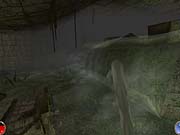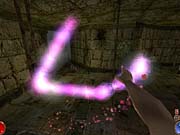Arx Fatalis Preview
Is this the spiritual successor to Ultima Underworld? Read our impressions and find out.
Ultima Underworld. Say those two words and watch the eyes of a role-playing game veteran light up. The Looking Glass classic and its sequel from the early 1990s redefined fantasy role playing, and for some, it remains the pinnacle of the genre. A first-person perspective and three-dimensional depth moved gameplay to a level that had the capacity to amaze people with its complexity. In an era when Doom represented the best that gaming could offer in terms of interactivity with a 3D world, the Ultima Underworld series let you battle monsters, cast spells, solve puzzles, and even leap chasms.

Arx Fatalis. Say those two words, and you won't get much of a reaction from the old-timers. At least for now--give Arkane Studios another month, and the title of its first game might wind up on the lips of both nostalgic role players and those who don't care about the lineage of their latest fave, as long as the game itself is good. The name should have more meaning for the former, however, as Arx Fatalis is being constructed as sort of an unofficial sequel to the Ultima Underworld games. Nearly everything that people fondly remember about those long-ago originals has been resurrected, from the first-person camera to the dank underground setting and charnel house atmosphere.
"We're fans of the Ultima Underworld and the [original] Ultima series, so yes, you'll find a lot of similarities," explained Raphael Colantonio, CEO of Arkane Studios. "In fact, fans of these games will find some Easter eggs in homage to these games as well. Originally, we even thought of getting the Ultima Underworld license for the game, so we contacted Paul Neurath, former founder of Looking Glass, who was willing to help us in that regard. But then things started getting more complicated on the Electronic Arts [EA acquired the rights to the Ultima games when it purchased the series' original publisher, Origin Systems] side of the license..."

Judging from a demo build that we've been looking at, Arkane is doing a good job of re-creating that gloomy Ultima Underworld charm. The dark ambience starts with the plot, which mirrors that of the original in important ways yet takes divergent paths in enough places so that gamers avoid feeling déjà vu. Most importantly, you're not a convict struggling to survive in a cavernous prison that's the medieval equivalent of the Big Apple in Escape From New York. You play a lone human adventurer on a world where the disappearance of the sun has forced residents of the city-kingdom of Arx to move underground to the former dwarven mines. This new take on city planning worked for a while, but the close-quarters existence soon led to a renewal of hostilities between humans and their old enemies, such as goblins, trolls, and ratmen. In the middle of this conflict, you awaken in a goblin jail cell (OK, so perhaps we're not that far removed from the prison theme of Ultima Underworld) with no memory of your identity, although your cell mate gives you the name of Nam Shagaar, which is local lingo for "John Doe."
From these humble beginnings, you move on to a heroic career and save civilization from stinky evil. Your primary goal is the destruction of the cult of Akbaa, a secretive organization that seeks to return the god of destruction and chaos to the world. If you succeed, you just might be able to discover a way of bringing back the sun. If you fail, you'll be living in a world where Elton John will never need to sing "Don't Let the Sun Go Down on Me."
Interface and Interaction

So there's nothing new about the "Kill Foozle" plot. The man-of-mystery hero--so mysterious that he has amnesia--has been used so many times that laws should be enacted against it. From these hackneyed beginnings, however, Arx Fatalis moves off in directions left unexplored by the likes of Baldur's Gate and Planescape Torment. The first-person interface is the most striking distinction here.
"We've always believed that first-person is the most immersive point of view that can be offered to players," said Colantonio. "Considering that immersion is one of the key features for an RPG, I wonder why new generation RPGs still don't go with the first-person perspective. Also, going first-person for a game that has the depth of traditional top-down-view RPGs was an interesting challenge for us. Hopefully, going first-person will open RPGs to a larger public as well."
The user interface has also been crafted to promote a sense of immersion. There are two ways to control your character, and both are different from what you're accustomed to in a first-person perspective game. One is an old-fashioned mouse cursor method--you hold down the right mouse button to swivel your head and use the keyboard to move. The other is similar, although you press and release the right mouse button once to activate the mouse-look feature and again to freeze your viewing angle and access the cursor needed to accomplish tasks. Both are reminiscent of Ultima Underworld. They manage to slow the first-person gameplay to a measured pace more appropriate to an RPG, although contemporary gamers might find them awkward because there is usually an extra click to be made during the transition between moving and picking up objects or fighting.

Interacting with the gameworld might take some getting used to. Although you pick up and activate objects by simply running the cursor over them--and the inventory and paper doll systems could have been lifted from any one of a dozen role players released over the past five years--the combat system isn't nearly as straightforward. Arx Fatalis relies on an arcadelike system lifted almost whole from Ultima Underworld. To make an attack, you click and hold the left mouse button to draw back your weapon of choice. The strength of your attack is determined both by the amount of time you hold the mouse button and the direction in which you were moving when you started to swing your sword, ax, dagger, club, or one of the many other medieval available weapons. So if you flinch and release a strike early, or are simply moving in the wrong direction when you attack, even the most powerful character could hit nothing but air a lot of the time. Timing and agility with the mouse are key. In theory, this should promote a more organic feel to fighting than the clickfest routine of recent third-person RPGs. In practice, it might be difficult for gamers to appreciate. Especially the traditional types who don't want any arcade action getting in the way of their adventuring.
Magic also requires more of the player than is typically asked. To cast a spell, you still collect runes as in Ultima Underworld. But instead of simply grouping certain configurations of them together to cast a particular incantation, you have to hold down the Ctrl key and draw the runes onscreen with hand gestures. Again, this is a fantastic idea that will take some time to get used to. While it is a lot of fun to "manually" cast spells, proper use of the system requires that you actually memorize rune patterns, as you can store only three patterns at a time for immediate recall. Hard-core types will love this, though it isn't hard to imagine casual players finding that the system demands too much.
The Other Stuff
Other aspects of play are less controversial. Players advance their characters by gaining experience points and advancing four character statistics (strength, mental, dexterity, and constitution) and nine skill attributes (close combat, projectile, defense, magic, object knowledge, ethereal link, stealth, technological skill, and intuition). There are no classes, so feel free to specialize in whatever categories you like. Health and mana points, armor class, magic resistance, and poison resistance round out the base stats. Game design lets you create just about any type of character you like and still have a good chance at vanquishing the bad guys. While you can certainly guide stereotypes like the powerful warrior or the mystical wizard to victory, you can also go for a middle-of-the-road sort with abilities in all areas. Combat isn't a necessity a lot of the time. Develop your stealth skill rating highly enough, and you can slip past enemies. Work on intuition, and you might be able to discover a secret passage leading past a group of enemies. In other cases, you'll solve puzzles or talk with NPCs to advance the plot. Few of these scenarios are on display in the demo, although there is a noticeable attempt to avoid hack-and-slash repetition.

Presentation should be a strong aspect of Arx Fatalis. Where third-person isometric games focus on architectural detail and intricate tile backgrounds, Arkane's use of first-person requires more emphasis on characters and atmospheric elements. The 3D engine used to make the game seems up to the task, based on our impressions from the demo. Although a fair bit of work remains to be done regarding collision detection, the end product could emerge as one of the better-looking RPGs seen in some time. High polygon counts on the monster and NPC models make them look and move in a realistic fashion, while strong textures and a keen sense of knowing how to build atmosphere make for some dramatic settings.

Arkane has made it a priority to include a lot of nice visual touches. Your underground homeland has been filled in with countless little details that give every room and passage a unique character, as well as a semiruined appearance that fits the game's personality. Junk is scattered everywhere, as are corpses, chests, and the odd stray bone. Rats, frogs, and other vermin scamper across the stone. Cobwebs over the mouths of passageways must be torn open to proceed. And, in sort of a throwback to another Looking Glass legend, torches flicker across walls much like they did in Thief: The Dark Project and Thief II: The Metal Age. Lighting effects provide the biggest visual boost to gameplay, which is what you might expect in a game that takes place far underground. Along with the way that torches dance on walls, they also illuminate objects and serve to cast long shadows everywhere. Again, the overall effect is quite similar to that seen in Thief, which certainly bodes well for the finished game.
Audio quality shows similar attention to detail so far. Background "music" is often little more than an ominous throbbing, also very similar to that used by Looking Glass in the Thief games. In-game effects are very well done. In the goblin prison depicted in the demo, you can hear the voices of prisoners, the odd squeak of rats, flowing water, and the crackle of torches. There is a lot of dialogue that's both well written and well acted. The goblin jailer that you have to kill in your escape attempt even taunts you while you're fighting him.
Arkane Studios is currently putting the finishing touches on Arx Fatalis. North American publisher Fishtank Interactive expects to have the game on shelves in mid-April, so check back with us at that time for full review coverage.
Got a news tip or want to contact us directly? Email news@gamespot.com
Join the conversation